Search the Special Collections and Archives Portal
Search Results
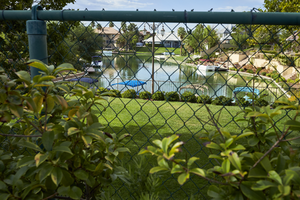
Waterway in The Lakes, Las Vegas, Nevada: digital photograph
Date
2017-08-29
Archival Collection
Description
A facility operated by The Lakes Association on South Lake North Drive offers a view of the waterway that give The Lakes development its name. This area is just south of West Sahara Avenue near South Durango Drive. August 29, 2017 UNLV Libraries Special Collections / Aaron Mayes N36 °08.438' x W115 °17.239')
Image
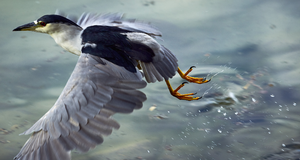
Black Crowned Night Heron in The Lakes, Las Vegas, Nevada: digital photograph
Date
2017-08-29
Archival Collection
Description
A Black Crowned Night Heron is seen next to Lake Sahara, a private pond that gives The Lakes its name. Built in the 1980s, The Lakes is one of the last development's with a manmade lake as its feature. This area is just south of West Sahara Avenue near South Durango Drive. August 29, 2017 UNLV Libraries Special Collections / Aaron Mayes N36 °08.359' x W115 °17.066')
Image
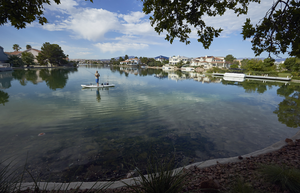
Fisherman on a kayak in The Lakes, Las Vegas, Nevada: digital photograph
Date
2017-08-29
Archival Collection
Description
A fisherman floats on a kayak in the private pond that gives The Lakes its name. Built in the 1980s, The Lakes is one of the last development's with a manmade lake as its feature. This area is just south of West Sahara Avenue near South Durango Drive. August 29, 2017 UNLV Libraries Special Collections / Aaron Mayes N36 °08.359' x W115 °17.069')
Image
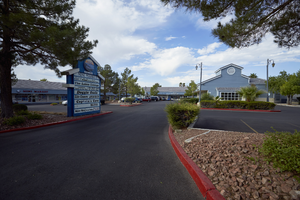
Lake Town Center in The Lakes, Las Vegas, Nevada: digital photograph
Date
2017-08-29
Archival Collection
Description
Lake Town Center sits along Lake East Drive in The Lakes master planned development. Built in the 1980s, The Lakes is one of the last development's with a manmade lake as its feature. This area is just south of West Sahara Avenue near South Durango Drive. August 29, 2017 UNLV Libraries Special Collections / Aaron Mayes N36 °08.345' x W115 °17.028')
Image
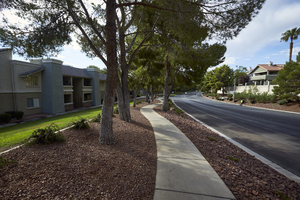
Lake Town Center in The Lakes, Las Vegas, Nevada: digital photograph
Date
2017-08-29
Archival Collection
Description
Desert landscaping has replaced grass in this portion of Lake East Drive in The Lakes master planned development. Built in the 1980s, The Lakes is one of the last development's with a manmade lake as its feature. This area is just south of West Sahara Avenue near South Durango Drive. August 29, 2017 UNLV Libraries Special Collections / Aaron Mayes N36 °08.302' x W115 °16.973')
Image

Allanza at the Lakes apartment complex in The Lakes, Las Vegas, Nevada: digital photograph
Date
2017-08-29
Archival Collection
Description
Allanza at the Lakes apartment complex on Starboard Drive is a transition between South Durango Drive and the high end homes that line the manmade lakes. Built in the 1980s, The Lakes is one of the last development's with a manmade lake as its feature. This area is just south of West Sahara Avenue near South Durango Drive. August 29, 2017 UNLV Libraries Special Collections / Aaron Mayes x )
Image
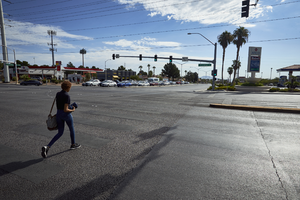
Pedestrian crosses South Durango Drive at West Sahara Avenue, Las Vegas, Nevada: digital photograph
Date
2017-08-29
Archival Collection
Description
A pedestrian crosses South Durango Drive at West Sahara Avenue. The corner features the Canyon Gate Country Club and The Lakes developments along with typical commercial zones to the east. August 29, 2017 UNLV Libraries Special Collections / Aaron Mayes N36 °08.633' x W115 °16.748')
Image
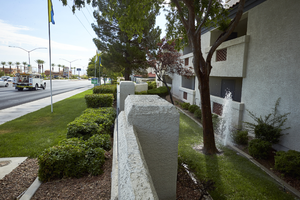
Water flowing from a broken water line, Las Vegas, Nevada: digital photograph
Date
2017-08-29
Archival Collection
Description
A broken sprinkler line bubbles up at The Enclaves apartments on West Sahara Avenue east of South Durango Drive. August 29, 2017 UNLV Libraries Special Collections / Aaron Mayes N36 °08.630' x W115 °16.523')
Image
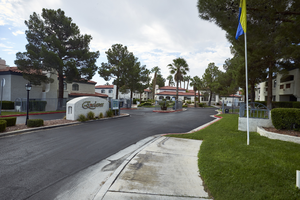
Entrance to The Enclaves apartments on West Sahara Avenue, Las Vegas, Nevada: digital photograph
Date
2017-08-29
Archival Collection
Description
The entrance to The Enclaves apartments on West Sahara Avenue east of South Durango Drive. August 29, 2017 UNLV Libraries Special Collections / Aaron Mayes N36 °08.630' x W115 °16.473')
Image
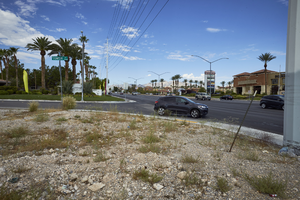
Grass use and vacant lot along West Sahara Avenue, Las Vegas, Nevada: digital photograph
Date
2017-08-29
Archival Collection
Description
One corner of West Sahara Avenue at South Tomsik Street features a marque with generous use of grass for the Vintage at the Lakes apartments while the other corner is an undeveloped vacant lot. August 29, 2017 UNLV Libraries Special Collections / Aaron Mayes N36 °08.622' x W115 °16.317')
Image
Pagination
Refine my results
Content Type
Creator or Contributor
Subject
Archival Collection
Digital Project
Resource Type
Year
Material Type
Place
Language
Records Classification
